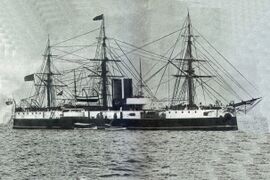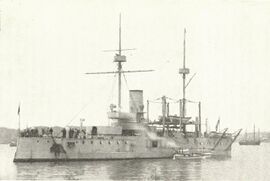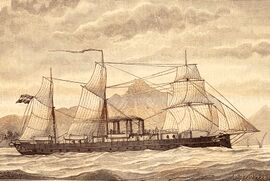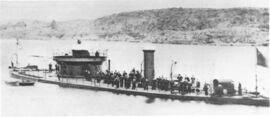Engineering:List of ironclads
The list of ironclads includes all steam-propelled warship (supplemented with sails in various cases) and protected by iron or steel armor plates that were built in the early part of the second half of the 19th century, between 1859 and the early 1890s. The list is arranged alphabetically by country. The initial dates of the boats correspond to the launch time, followed by a separation that indicates their retirement or final date.
The list includes ironclads of two different categories or roles, oceanic and coastal (the latter may be floating batteries, monitors and coastal defence ships). The various ironclads design such as the ram, broadside, central battery (or casemate), turret and barbette will be mentioned.[upper-alpha 1] Some of these ocean ironclads can be classified as armored frigates, armored corvettes, or others based on their displacement. Wooden hull ships that have been subsequently armored will also be considered in this list.
Although the introduction of the ironclad is clear-cut, the boundary between 'ironclad' and the later 'pre-dreadnought battleship' is less obvious, as the characteristics of the pre-dreadnought evolved from 1875 to 1895. For the sake of this article, a line is drawn around 1890, differing from country to country.
Americas
Argentina
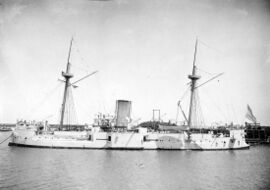
- Monitors
- Central battery ironclad
- Almirante Brown (1880) - retired in 1932
- Coastal defence ships
- Independencia class
- Independencia (1891) - retired in 1946
- Libertad (1892) - retired in 1946
Brazil
- Central battery ironclads (or casemate)
- Brasil (1864) - retired in 1879
- Tamandaré (1865) - retired in 1879
- Barroso (1865) - retired in 1882
- Rio de Janeiro (1866) - sunk by floating mines ('torpedoes') in the River Paraguay in 1866, during Paraguayan War
- Mariz e Barros class
- Mariz e Barros (1865) - stricken in 1897
- Herval (1865) - stricken in 1885
- Cabral class
- Sete de Setembro (1874) - sunk after fire, during Fleet Revolt of 1893–94
- Monitors
- Bahia (1865) - struck in 1894
- Pará class
- Pará (1867) - discarded in 1884
- Rio Grande (1867) - scrapped in 1907
- Alagoas (1867) - scrapped in 1900
- Piauí (1868) - scrapped in 1893
- Ceará (1868) - scrapped in 1884
- Santa Catharina (1868) - sank in 1882 at her moorings due to the poor condition of her hull
- Javary class
- Ironclads turret ship
- Lima Barros (1865) - struck in 1894
- Silvado (1865) - struck in 1880
- Riachuelo (1883) - retired in 1910
- Aquidabã (1885) - sank after an explosion during a routine cruise in 1906
Chile

- Central battery armored frigates
- Almirante Cochrane class
- Almirante Cochrane (1874) - alienated in 1933
- Blanco Encalada (1875) - sunk in 1891 in the Battle of Caldera Bay, during Chilean Civil War of 1891
- Ironclad turret ship
- Huáscar* (1865, ex Peruvian ship) - captured in the Battle of Angamos in 1879 during War of the Pacific, retired in 1896 and turned into a historical relic in 1934
Haiti
- Casemate ironclad
- Triumph (1861, ex British merchant Fingal and then USS Atlanta) - lost at sea in 1869 shortly after the purchase
Peru
- Monitors
- Victoria (1864) - unknown ending
- Canonicus class
- Atahualpa (1864, ex USS Catawba) - acquired in 1868 and sunk in the Blockade of Callao in 1881, during War of the Pacific
- Manco Cápac (1864, ex USS Oneota) - acquired in 1868 and sunk in the Battle of Arica in 1880, during War of the Pacific
- Broadside armored frigate
- Independencia (1865) - ran aground in the Battle of Punta Gruesa in 1879, during War of the Pacific
- Ironclad turret ship
- Huáscar* (1865) - captured by the Chileans at the Battle of Angamos in 1879, during War of the Pacific
- Casemate ironclad
- Loa (1854/1865)[upper-alpha 2] - sunk in the Blockade of Callao in 1881, during War of the Pacific
United States
Asia
China
- Coastal defence ships
- Tien-sing (after 1875) - unknown
- Pingyuan (1890) - captured by the Japanese in 1895 after Battle of Weihaiwei, during First Sino-Japanese War
- Ironclads turret ship
Japan
- Ironclad ram
- Kōtetsu* (1864, as CSS Stonewall) - acquired from the United States in 1869 and retired in 1888
- Armoured corvettes
- Ryūjō (1869) - retired in 1906
- Kongō class
- Central battery ironclad
- Fusō (1877) - sold for scrap in 1909
- Ironclad turret ship
- Chin'en (1882, ex Chinese ship Zhenyuan) - captured in 1895 during First Sino-Japanese War and retired in 1911
- Coastal defence ship
- Heien (1890, ex Chinese ship Pingyuan) - captured in 1895 during First Sino-Japanese War and sunk by adverse weather causes during Russo-Japanese War
Ottoman Empire
Siam
- Floating battery
- Siam Mongkut (1870) - probably discarded 1912
Europe
Austria-Hungary
Denmark
- Broadside armored frigates
- Danmark (1864) - scrapped 1907
- Dannebrog (1850/1864)[upper-alpha 3] - retired in 1897
- Peder Skram (1864) - scrapped 1897
- Ironclad turret ship
- Rolf Krake (1863) - scrapped 1907
- Ironclad ram
- Stærkodder (1864, as CSS Stonewall) - the Danish purchase in 1864 of this ship failed and ended up being sold to Japan in 1867 and renamed Kōtetsu*
- Monitors
- Casemate ironclad
- Odin (1872) - retired in 1912
- Barbette ironclads
- Helgoland (1878) - retired in 1907
- Tordenskjold (1880) - retired in 1908
- Iver Hvitfeldt (1886) - retired in 1919
France
Germany
Greece
- Central battery armored corvette
- Vasilefs Georgios (1867) - scrapped in 1915
- Broadside armored corvette
- Vasilissa Olga (1869) - scrapped in 1925
- Barbette ironclads
Italy
Netherlands
- Casemate ironclad
- De Ruyter (1853/1863)[upper-alpha 4] - unknown
- Ironclads turret ship
- Prins Hendrik der Nederlanden (1866) - scrapped after 1905
- Koning der Nederlanden (1874) - scuttled in 1942, during World War II
- Monitors
- Buffel class
- Schorpioen class
- Schorpioen (1868) - converted into a museum ship in 1982
- Stier (1868) - struck in 1908
- Heiligerlee class
- Heiligerlee (1868) - sold for scrapping in 1910
- Krokodil (1868) - unknown
- Tijger (1868) - unknown
- Bloedhond class
- Adder class
- Draak (1877) - unknown
- Matador (1878) - unknown
- Reinier Claeszen (1891) - unknown
Norway
- Monitors
- Skorpionen class
- Skorpionen (1866) - scrapped in 1908
- Thrudvang (1869) - scrapped in 1918
- John Ericsson class
- Mjølner (1868) - scrapped in 1909
- Thor (1872) - wrecked in 1919
Portugal
- Central battery ironclad
- Vasco da Gama (1876) - broken up in 1935
Russia
Spain
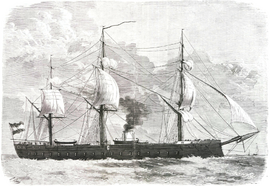
- Broadside armored frigates
- Tetuán (1863) - sunk by accident or sabotage in the siege of Cartagena in 1873, during Cantonal rebellion
- Numancia (1863) - retired in 1912
- Arapiles (1864) - scrapped in 1883
- Vitoria (1865) - retired in 1911
- Central battery armored frigates
- Zaragoza (1867) - stricken in 1896
- Sagunto (1869) - retired in 1896
- Méndez Núñez (1861/1870)[upper-alpha 5] - scrapped in 1896
- Floating battery
- Duque de Tetuán (1874) - retired in 1900
- Monitor
- Puigcerdá (1874) - retired in 1900
- Barbette ironclad
- Pelayo (1887) - scrapped in 1925
Sweden
- Monitors
- John Ericsson class
- HSwMS John Ericsson (1865) - sold in 1919
- HSwMS Thordön (1865) - sold in 1922
- HSwMS Tirfing (1866) - sold for scrap in 1922
- HSwMS Loke (1869) - scrapped in 1908
- HSwMS Garmer (1867) - sold for scrap in 1893
- HSwMS Sköld (1868) - sunk as a target in 1907
- HSwMS Fenris (1872) - retired in 1903
- Hildur class
- HSwMS Hildur (1872) - sold in 1919
- HSwMS Gerda (1872) - retired in 1919
- HSwMS Ulf (1873) - sold in 1919
- HSwMS Berserk (1874) - sold in 1919
- HSwMS Björn (1874) - sold in 1919
- HSwMS Sölve (1875) - sold in 1919
- HSwMS Folke (1875) - decommissioned in 1919
- Coastal defence ships
United Kingdom
See also
- List of battleships
- List of cruisers
- List of battlecruisers
Notes
- ↑ These designs are for oceanic ironclads, although there were also coastal ironclads that used ram, casemate, turret and barbette.
- ↑ Built in 1854 as a wooden steamship and converted to a casemate ironclad in 1865.[3]
- ↑ Originally it was a 70-gun ship that became an armored frigate between 1862 and 1864.[4]
- ↑ It was converted into a casemate ironclad between 1961 and 1863.
- ↑ It was a steam frigate called Resolución that in 1870 ended up being converted into an armored frigate of the central battery, adopting the new name of Méndez Núñez.
References
- ↑ Rodríguez, Horacio (1995) (in es). Las fuerzas navales argentinas: historia de la flota de mar. Instituto Browniano. p. 140.
- ↑ Scheina, Robert L. (1987). Latin America: A Naval History, 1810–1987. Annapolis, Maryland: Naval Institute Press. p. 64. ISBN 0-87021-295-8.
- ↑ López Martínez, Héctor (1972) (in es). Historia maritima del Peru: La república, 1876-1879. Comisión para Escribir la Historia Marítima del Perú, Editorial Ausonis. p. 262.
- ↑ Silverstone, Paul H. (1984). Directory of the World's Capital Ships. New York: Hippocrene Books. p. 55. ISBN 0-88254-979-0.
- ↑ Sondhaus, Lawrence (1958). Navies in Modern World History. London: Reaktions book ltd. p. 142.
Bibliography
- Gardiner, Robert, ed (1979). Conway's All the World's Fighting Ships 1860–1905. London, UK: Conway Maritime Press. ISBN 0-85177-133-5. https://archive.org/details/conwaysallworlds0000unse_l2e2.
 |
